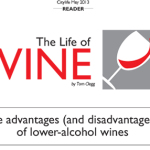
You, like me, have probably had cause to mutter recently: ‘Christ it’s filthy hot in Chiang Mai’, while coughing up a lung or two and wondering if a trip to the optometrist might be in order because you can’t see quite as well as you used to. Because most of us feel like we have a permanent hangover in this dirty heat, I have decided that this month we should take a brief look at wines with slightly less alcohol in them.
Lower-alcohol wine is an excellent option for those who fancy a glass or two of something cold, crisp and refreshing – at a time when the local farmers are celebrating being just inches from the sun by turning up the central heating across swathes of the countryside – but don’t want their dehydrated, smog-filled brain to capsize completely.
There’s not much point in seeking out a low-alcohol red wine as anything that comes in much below the 12% mark is best avoided. So, red wine is out.
Anything white that comes in under around seven % is likely to be classed as a ‘wine-style’ drink because the powers that be have strict rules on how much alcohol has to be present for a wine to be called a wine. Most wines being uncorked around the world come in at somewhere between 12 and 14%.

The simple science behind alcohol in wine is to do with the natural yeasts and sugars in the grape working together to produce the stuff that gets one pissed through the process of fermentation. This stuff is called ethanol. As a grape ripens, it produces sugar, so most winemakers looking to make a drink with lower ethanol content will pick the grapes early in order to cut off sugar development. The climate is also a factor, and lower-alcohol wines are usually produced in cooler parts of the world where the grapes naturally produce less sugar.
Some of those far more knowledgeable than me suggest that the current explosion in the demand for lower-alcohol wine may have been sparked for health reasons, but I’m more inclined to go for the far simpler reason that if a wine can’t be classed as a wine because it has too little alcohol in it, then it can’t be taxed as a wine. The wallet has always been mightier than the waistline.
But there has definitely been an increase recently in the demand for grape juice that doesn’t deliver the booze punch of an Australian Shiraz.
Winemakers are clever people and what the customer wants, the customer usually gets. And so there are various ways of artificially removing the ethanol. These involve men in white coats who hang around in labs with pipettes and conical-flasks using gynaecological sounding terms like membrane techniques, reverse osmosis and vacuum evaporation.
Unfortunately, wine really doesn’t like being badgered about and tends to go a bit sweet and sticky after having, what is after all, one of its key ingredients all but removed.
My top tip for reducing the alcohol in a glass of wine is far less scientific – just chuck in some water. If anyone frowns at you for doing this, just tell them that the bloody French do it all the time, and they’re brilliant at wine. Or perhaps plonk in a couple of ice cubes. Or what about making a spritzer with a dash of soda? Now that’s class.
So here are some wines to look out for: Semillon is usually lower in alcohol because it is an earlier ripening grape. German Reisling is a good bet because it’s cold in that part of the world. Portugal’s Vino Verde is less of a booze bomb while also being gentle on the wallet. For those who like their fizz, Italy’s Prosecco and Cava from Spain tend to be kinder on the head than other sparklers. Not wanting to leave lovely Thailand out, why not pop into 7-Eleven and pick up a SPY Wine Cooler? The Siam Winery makes the rather ambitious claim that this ‘grape wine’ is ‘a healthy alcoholic drink’. Cheers.
